
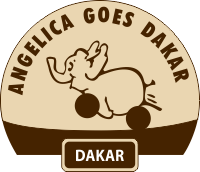
Desafio Ruta 40 / 19.06.2016 die Dünen – the dunes Tagebuch / Diary
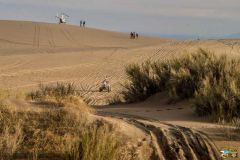
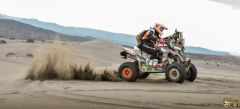
Und dann bekomme ich den Rallye-Spirit zu spüren. Plötzlich tauchen aus dem Nichts zwei Motorradfahrer auf. Private Zuschauer, die mich gleich fragen, ob sie mir helfen können. SELBSTVERSTÄNDLICH! Sie haben meinen Quad Big Brother schnell aus seiner misslichen Lage befreit und weiter geht es. Sie klopfen mir auf die Schultern und sagen, ich sei richtig auf dem Weg. „Fahr weiter, wir holen Dich schon wieder ein. Wir helfen nun noch schnell einem anderen Fahrzeug, was eingegraben ist.“ Also schwinge ich mich wieder in den Sattel und weiter geht die wilde Fahrt.
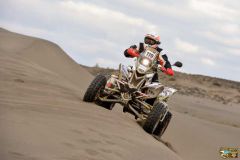
So, also wieder weiterfahren. Inzwischen bin ich schon ein wenig flotter unterwegs. Auch die Dünenabfahrten auf der steilen Seite fangen an Spass zu machen. Ich schüttle über mich selber den Kopf. Ein wenig der falsche Moment, im Rennen das Dünen fahren zu lernen, aber was soll ich machen. Es geht immer weiter hinein in den Sandkasten und die Auf- und Abfahren werden immer steiler, immer höher. Gerade, als die Fahrt mal angenehm ist, sehe ich auf der linken Seite, abseits der Fahrspuren eine KTM stehen und einen Motorradfahrer, der bei meinem Anhalten mir zuruft: „Hast Du ein Überbrückungskabel dabei?“. Habe ich.
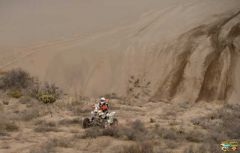
Gerade als ich mir die Handschuhe überstreife, kommen die beiden Motorradfahrer, meine Rettungsengel vorbei, halten an und sagen, dass sie mich nun auf dem weiteren Weg begleiten werden. Ich folge den beiden und grabe mich an einer hohen Düne wieder ein. Obwohl ich Vollgas gebe im zweiten Gang, schaffe ich es nicht bis auf den Kamm. Mist! Das Absteigen per Rückwärtsrolle habe ich inzwischen voll im Griff. Die beiden Motorradfahrer fragen mich nach einer Weile, ob sie mich auf dem schnellsten Weg auf die Hauptstrasse führen sollen oder ob ich im Renne bleiben wolle. Ich will im Rennen bleiben, aber wenn es eine Abkürzung zu Check Point 1 geben würde, könnten wir den gerne nehmen.
Wir nehmen die Abkürzung. Was ich zu dem Zeitpunkt nicht weiss, ist, dass Fernando in San Rafael im Biwak neben der GPS-Überwachung der Piloten bei der Organisation sitzt. Dort sieht er auf einem Bildschirm viele kleine Punkte mit Startnummern versehen. So sieht er auch jeden meiner Haltepunkte und wenn ich wieder weiterfahre. Er sieht so auch, dass ich die offizielle Piste verlasse. Der Schreck fährt allen Beteiligten in die Glieder, denn sie können ja nicht wissen, dass ich zwei Lotsen folge, die mich mit einer Abkürzung zum Check Point führen.
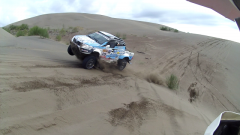 Ich verabschiede mich von den Motorradfahrern ohne deren Namen erfahren zu haben, alles geht so schnell und schon bin ich wieder unterwegs über einen Weg, der von Huks nur so wimmelt. Huks sind übergrosse Bodenwellen, die in unterschiedlichen Abständen und unterschiedlicher Höhe die Fahrt zu einem hüpfenden Ritt werden lassen.
Ich verabschiede mich von den Motorradfahrern ohne deren Namen erfahren zu haben, alles geht so schnell und schon bin ich wieder unterwegs über einen Weg, der von Huks nur so wimmelt. Huks sind übergrosse Bodenwellen, die in unterschiedlichen Abständen und unterschiedlicher Höhe die Fahrt zu einem hüpfenden Ritt werden lassen.
Ich komme am Check Point an und meine Karte wird abgestempelt. Der weitere Weg wird ganz anders aussehen, als die Sandhügel. Ich bin heilfroh, es bis hierher geschafft zu haben.
After 10 easy kilometres I reach the open landscape of the dunes. I’m curious how it will be and if I can find the right way. Navigation will be very important during the next kilometres. But before I come to the high sand hills I have to deflate the tires. It feels very long how I have the right pressure, but this is only my impatience. Now I note that my handicap with the motocross glasses is more important than I have thought. I have positioned the glasses over my mouthguard of the helmet. The glasses fog because of my breath. I lose time to the moment I can see clearly. But keep calm, the stage is still long. My ride is not very fast. I do not want to fall of the quad in the steep descent of the dunes and destroy myself of my quad during the first kilometres.
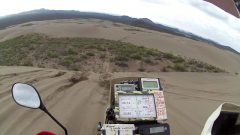 That I am right is checked very easily. First, there are the tracks in the sand and second I pass by spectators and photographers. Very good up to the moment the sand catches me. As far as good until I stick in the sand up to the rear axle and it is steep. On a normal way I can not get off the quad. So I slip backwards slowly and feel, that Big Brother is very firm. I drop off with a perfect reverse roll.
That I am right is checked very easily. First, there are the tracks in the sand and second I pass by spectators and photographers. Very good up to the moment the sand catches me. As far as good until I stick in the sand up to the rear axle and it is steep. On a normal way I can not get off the quad. So I slip backwards slowly and feel, that Big Brother is very firm. I drop off with a perfect reverse roll.
And now? Where shall I start to dig? I knew before the start, that I have not enough experience with sand and dunes. And by the way I’m all alone here, no other vehicle. In a sudden, the rally spirit is reaching me. Two motor bikers are coming out of the nowhere. 2 private spectators are coming along and ask me, whether I need help. OF COURSE! They get out Big Brother very fast and I can continue. But before I jump into the saddle they tell me: “You are on the right way. Go on. We will get you in a while, but before we are going to help another rider who sticks in the sand.”
After a few kilometres, I can not tell you after how many kilometres, I stick in another dune. A car jumps up tot he dune, just a few metres nex to me and covers me with sand. And another car gets buried on the top of the dune. In the meantime I see, that I lose gasoil of my spare tank on the right side. What a mess! And now? A VW Amarok stops. Martin Maine offers his help. YES, PLEASE! He singles out the quad of the sand, we take out the gear and with a push Big Brother goes downhill backwards. Martin comes downhill, too, backwards and shows me, how I can climb up the dune on an easier way.
So, let’s go on. In the meantime I’m a little bit faster. Also to drive downhill the steep part of the dunes is very fun. But I’m thinking about what I’m doing. Normally it’s not the moment to learn to drive in the dunes during a race, but I have no other choice.
I go on and on and the sand hills are going to be higher and higher. Just in the moment I feel comfortable I see a KTM at the left side and the rider is asking me, when I stop, whether I have a jumper wire with me. I do have. The rally spirit is going to beg now, what I have got. I stop and we are connecting the two batteries. The KTM is charging very slowly and while we are waiting I’m filming a shot with my helmet camera. We agree to do the last part of the dunes together.
A Buggy stops and handles over a battery pack. Gonzalo, the pilot of the KTM tells me to prepare and continue alone. Just in the moment I have put on my gloves to two private motorbike pilots are coming to us. My two angels. They want to accompany me on the way out of this sand playing ground. I follow them and also giving full speed up to a dune, I stick again. Shit! But I have already good practise to get of the quad by reverse roll. The two riders ask me whether I want to go out of this place on the fastest way to the main street or whether I want to stay in race. I want to stay in race but if they know a faster and shorter way to get to check point 1 it would be appreciated. We take the shorter way.
What I do not know at this moment, that Fernando is in San Rafael in the bivouac with the organisation observing the GPS control. On a screen they see a lot of little points with the numbers of the pilots and know exactly where all the competitors are, if they have stopped or are still driving. They see my little point and how I leave the normal route. All of the are afraid and do not know what I’m doing. They can not know that I have two guides who are bringing me on the safe way to the check point.
I say good bye to my angels, without getting their names. Everything is going so fast and the last part of the way is covered with “huks”. Huks are oversized bumps with different distances and the quad jumps over this bumps At the check point I get another stamp on my card. The next part will be completely different and I’m very happy to get out of the sand. I’m very happy to have made it up to here.
Desafio Ruta 40 / 19.06.2016 Stage San Rafael – San Rafael Tagebuch / Diary
Start im Biwak: 06.45h
Start Spezialetappe 1. Fahrer: 07.45 h
Distanz Biwak – Start Spezialetappe: 77.87 km
Distanz Start Spezialetappe – Check Point 1: 78.39 km
Distanz Checkpoint 1 – Neutralisation: 184.95 km
Distanz Neutralisation: 35.35 km
Distanz Ziel Spezialetappe: 89.24 km
Distanz Ziel – Biwak: 83.53 km
Total Kilometer: 549.33 km
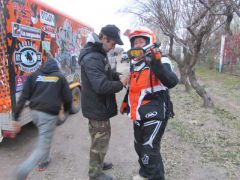
Fernando hilft mir beim Anziehen. Da ich einen Teil der Ausrüstung von ihm geliehen bekommen habe und nicht passend gekauft habe, gibt es ein paar Handicaps. Ich kann zum Beispiel nach dem Anlegen des Hans, des Halskragens, meine Hände nicht mehr genügend hoch an den Helm heben, um meine Crossbrille zu richten.
Aber da alles interessiert mich nun nicht wirklich, sondern ich freue mich auf den ersten Start. Der grosse Bogen mit der Digitaluhr wartet auf mich. Vorher wird noch meine Zeitkarte abgestempelt und das GPS überprüft, ob es richtig eingestellt ist. Die Offiziellen der Organisation nähern sich dick eingekleidet jedem Fahrzeug.
Mein Puls ist ganz ruhig, meine Konzentration auf dem Start und ich verspüre überhaupt keine Nervosität.
Dann ist es soweit. Wieder so ein Moment, auf den ich jahrelang gewartet habe. Der Starter winkt mich mit ausgestrecktem Arm zu sich, drückt auf den Knopf auf der Uhr und der Countdown läuft. 20 – 19 – 18 …
Mein Start ist hervorragend. Genau in dem Bruchteil der Sekunde, in der die Uhr von 1 auf 0 springt, fahre ich los. Jetzt geht es ab in die Dünen von Nihuil auf den ersten Teil der Spezialetappe.
Start at bivouac: 06.45h
Start special 1. driver: 07.45 h
Distance bivouac to start special: 77.87 km
Distance start special to check point 1: 78.39 km
Distance check point 1 to neutralisation: 184.95 km
Distance neutralisation: 35.35 km
Distance goal special: 89.24 km
Distance goal to bivouac: 83.53 km
Total kilometres: 549.33 km
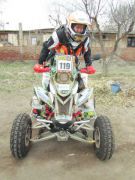
Fernando is going to help me to get dressed. He loaned me a part of the equipment and it does not fit as if I would have bought it for me. So, when I have put on the Hans, neck protector, I can’t reach any more the motocross glasses properly. But this fact does not interest me at the moment. I’m looking forward to the first start. The big acre with the digital watch is waiting for me. Before my time card is stamped and the GPS is checked by some officials of the organisation, all very well protected against the cold.
My pulse is calm, my concentration only on the start and I do absolutely not feel any nervousness.
And then the moment, I waited for many years, arrives. The starter is going to call me with his arm to the start line, he pushes the button and the clock starts with the countdown: 20 – 19 – 18…
My start is perfect. Just in this fraction of the second, when the number 1 disappears and the 0 is going to shine up, I started from the line. Now, my way is going to the dunes of Nihuil and the first part of the special.
Desafio Ruta 40 / 18.06.2016 Start Tagebuch / Diary
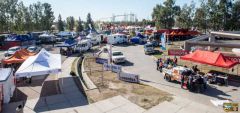 Als ich heute morgen um 08.00 h aus meinem Schlafsack krieche und mich warm anziehe, ist es draussen noch dämmrig. Das Biwak ist noch völlig ruhig. Die Mechaniker haben heute Nacht bis spät noch gearbeitet, weil am Quad von Gaston die Ölpumpe nicht mehr funktioniert hat. Sie haben das Teil auseinandergenommen und gesehen, dass dort ein paar Teile nicht mehr so aussahen, wie sie sein mussten. Gaston hat via Facebook mit einem Piloten Kontakt hergestellt, der so ein Ersatzteil hatte. Nun dieser Pilot war 260 km entfernt in der Stadt Mendoza. Dieser Pilot, dessen Namen ich leider nicht kenne, hat sich nach Mitternacht ins Auto gesetzt und ist nach San Rafael gefahren. Als er bei uns im Biwak ankam, war es gegen 3 Uhr in der Nacht. Um 5 Uhr morgens, war die Maschine wieder repariert und fahrtüchtig.
Als ich heute morgen um 08.00 h aus meinem Schlafsack krieche und mich warm anziehe, ist es draussen noch dämmrig. Das Biwak ist noch völlig ruhig. Die Mechaniker haben heute Nacht bis spät noch gearbeitet, weil am Quad von Gaston die Ölpumpe nicht mehr funktioniert hat. Sie haben das Teil auseinandergenommen und gesehen, dass dort ein paar Teile nicht mehr so aussahen, wie sie sein mussten. Gaston hat via Facebook mit einem Piloten Kontakt hergestellt, der so ein Ersatzteil hatte. Nun dieser Pilot war 260 km entfernt in der Stadt Mendoza. Dieser Pilot, dessen Namen ich leider nicht kenne, hat sich nach Mitternacht ins Auto gesetzt und ist nach San Rafael gefahren. Als er bei uns im Biwak ankam, war es gegen 3 Uhr in der Nacht. Um 5 Uhr morgens, war die Maschine wieder repariert und fahrtüchtig.
Das ist der Geist der Cross Country Rallye, der Geist der Rallye Dakar. Man macht Unmögliches möglich, man hilft, wo man kann, wenn man sich auch noch nie persönlich begegnet ist. Zu dem Zeitpunkt weiss ich noch nicht, dass mich dieser Geist ebenfalls erfassen wird.
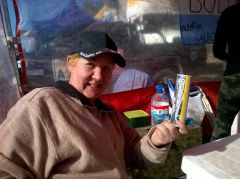 Im Biwak ist alles ruhig. Ich mache gemütlich meinen Toilettengang und bewundere den Sonnenaufgang. Das ist die Gelegenheit, um meinem inneren Kompass nun ganz präzise auf die südliche Hemisphäre einzustellen. Instinktiv suchen wir Menschen, die auf der nördlichen Hemisphäre aufgewachsen sind, immer Norden in der falschen Richtung. Im Geiste versuche ich mir meinen Standpunkt ganz genau ins Gedächtnis zu rufen und drehe mich gen Nordosten, wo die Sonne am Horizont erscheint. Nun justiere ich meinen inneren Kompass, suche langsam nach den Bildern auf der inneren Landkarte, orientiere mich, wo die Anden sind und lasse diesen Eindruck ganz lange auf mir wirken.
Im Biwak ist alles ruhig. Ich mache gemütlich meinen Toilettengang und bewundere den Sonnenaufgang. Das ist die Gelegenheit, um meinem inneren Kompass nun ganz präzise auf die südliche Hemisphäre einzustellen. Instinktiv suchen wir Menschen, die auf der nördlichen Hemisphäre aufgewachsen sind, immer Norden in der falschen Richtung. Im Geiste versuche ich mir meinen Standpunkt ganz genau ins Gedächtnis zu rufen und drehe mich gen Nordosten, wo die Sonne am Horizont erscheint. Nun justiere ich meinen inneren Kompass, suche langsam nach den Bildern auf der inneren Landkarte, orientiere mich, wo die Anden sind und lasse diesen Eindruck ganz lange auf mir wirken.
So gegen 09.00 Uhr kriechen langsam alle aus ihren Schlafstellen. Es gibt Frühstück. Nun haben wir noch jede Menge Zeit bis wir um 16.00 h im Parque Fermée sein müssen hinter der Rampe. Diese Zeit nutze ich mit Fernando, um nochmals alle Symbole vom Road Book auswendig zu lernen. Vor allem die Abkürzungen sind sehr wichtig. Die Symbole sind da schon leichter. Präzise mache ich mich an die Markierungen im Road Book. Dann gehen wir nochmals die neuen Apparate durch. GPS mit seinen vielen Knöpfen, Iri-Track und das Sentinel. Beim Sentinel mache ich mir mit Malerabdeckband noch einen kleinen klebenden Spickzettel. Wenn ich beide Knöpfe gleichzeitig drücke, aktiviert sich ein Magnetfeld um meine Maschine. Jeder anderer Pilot, der nun mit seinem Fahrzeug und Sentinel in dieses Magnetfeld fährt, wird durch einen Alarm gewarnt. Das braucht man vor allem, wenn man an unübersichtlichen Stellen steht.
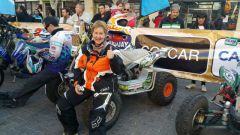 Die Werkzeuge werden nochmals kontrolliert. Ersatzsicherung kleben wir in den Innenteil des Towers. Die Schrauben am Helm, die vor allem das Dächlein halten, werden zusätzlich mit Klebestreifen fixiert. Die Taschen einer Rallyejacke werden befüllt. Dabei habe ich Klebeband, einen Led-Lampen-Clip für an den Helm und Ersatzbatterien. Diese Batterien werden am letzten Tag noch eine grosse Rolle spielen. Ersatzhandschuhe, Ersatzcrossbrille, Ovo-Riegel, Leatherman, Kabelbinder, Sicherungen, Kompass, Ausweise, Geld, Knusperriegel, Regenschutz und einen Apfel. Im Camelpack habe ich 4 Liter zu trinken. 2 Liter ein Gemisch aus Gatorade und Wasser und 2 Liter mit einem Gemisch aus Wasser und Hydrationssalzen.
Die Werkzeuge werden nochmals kontrolliert. Ersatzsicherung kleben wir in den Innenteil des Towers. Die Schrauben am Helm, die vor allem das Dächlein halten, werden zusätzlich mit Klebestreifen fixiert. Die Taschen einer Rallyejacke werden befüllt. Dabei habe ich Klebeband, einen Led-Lampen-Clip für an den Helm und Ersatzbatterien. Diese Batterien werden am letzten Tag noch eine grosse Rolle spielen. Ersatzhandschuhe, Ersatzcrossbrille, Ovo-Riegel, Leatherman, Kabelbinder, Sicherungen, Kompass, Ausweise, Geld, Knusperriegel, Regenschutz und einen Apfel. Im Camelpack habe ich 4 Liter zu trinken. 2 Liter ein Gemisch aus Gatorade und Wasser und 2 Liter mit einem Gemisch aus Wasser und Hydrationssalzen.
Im Biwak sind inzwischen viele Zuschauer eingetroffen. Man kann keine Bewegung machen, ohne dass man von vielen Augen beobachtet wird. Ich habe noch nie so viele Fotokameras und Handys auf mich gerichtet gehabt.
Und dann ist es soweit. Für die Fahrt über die Rampe und den symbolischen Start, müssen wir uns nicht in die volle Montur schmeissen. Jedoch Crossstiefel, Crosshose und Rallyejacke, Helm und Handschuhe sind ein muss. Die Fahrt durch die Stadt San Rafael wird mir immer in Erinnerung bleiben. Im Parque Fermée hinter der Rampe, in einem abgesperrten Bereich reihen wir unsere Maschinen auf. Es ist eine knisternde, ausgelassene, fröhliche, angespannte und ganz spezielle Atmosphäre.
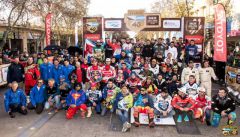 Wir werden alle zur Rampe gebeten, ohne Fahrzeuge, damit ein Gruppenfoto aufgenommen werden kann. Hier sind wir noch alle zusammen, alle Startenden. Dann folgt eine Showeinlage von Drift-Königen, die ihre Reifen zum Qualmen bringen und mit sehr viel Lärm auf einem „winzigen“ Parcours ihre Runden drehen.
Wir werden alle zur Rampe gebeten, ohne Fahrzeuge, damit ein Gruppenfoto aufgenommen werden kann. Hier sind wir noch alle zusammen, alle Startenden. Dann folgt eine Showeinlage von Drift-Königen, die ihre Reifen zum Qualmen bringen und mit sehr viel Lärm auf einem „winzigen“ Parcours ihre Runden drehen.
Um 17.00 h geht es los. Das erste Motorrad nimmt den Weg auf die Rampe. Jeder Pilot wird auf der Rampe begrüsst und vorgestellt und muss dann selber noch ein paar Worte sagen. Meine Rede habe ich im Kopf. Das ist auch gut so. Mein Puls schlägt glaube ich nicht mehr unter 120 Schlägen pro Minute.
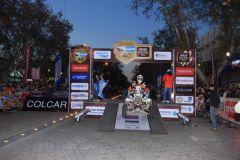
Auf der Rückfahrt ins Biwak gehen mir zuerst tausend Gedanken durch den Kopf, aber dann kann ich in den Konzentrationstunnel eintauchen. Nun geht es darum, alle Gedanken auf den morgigen Tag zu lenken. Die Pilotenroutine nicht zu vernachlässigen. Quad abstellen, Kleider sortieren, Briefing und Abendessen. Danach Zähneputzen, ab ins Bett.
I get up at 8 o’clock in the morning, put my warm cloth on, it‘s dim light outside and very cold. The bivouac is quiet. The mechanics have worked until 5 o’clock in the morning. The oil pump of Gaston’s quad has broken. They have dismounted it and seen, that a lot of parts were bad looking. Gaston has made a contact by Facebook to another pilot who has this spare part. But, this pilot is 260 kms far away from San Rafael. He lives in Mendoza. After midnight this pilot who’s name I don’t know, sits into the car. At about 3 o’clock he arrives in the bivouac and the mechanics finished to repair the quad after 2 hours.
This is the spirit of Cross Country Rallies. The spirit of the Rally Dakar. Impossible things will be made possible, everyone helps the other, even if you don’t know him personally. I will get in touch with this spirit very soon.
I go to the bathroom, walking through a silent bivouac. Then I observe the sun rise and I try to adjust my internal compass. The human beings, born in the northern hemisphere, are looking for north in a wrong direction. So I turn north-east to the sunrise, close my eyes and search my inner pictures of the landscape. I orientate myself where the Andes are and puzzle together the pictures.
9 o’clock and slowly the other members of the team wake up. Breakfast time and we have plenty time until the afternoon. At 4 o’clock pm we have to be in the Parque Fermée behind the ramp, where the race will be started. Together with Fernando I use this time to repeat all symbols and shortcuts from the road book. This is very important, but the symbols are much easier to learn. Then I prepare my first road book carefully. Then we repeat one again the buttons of the GPS, Iri-track and the sentinel. I make a mark on my sentinel. When I push both buttons at the same time, I activate a magnetic field around my machine. All other pilots, driving into this field get an alarm. This is very important to do if you stick somewhere not visible for other pilots.
We check once again all the tools and we fill the pockets of my rally jacket. I have with me: tape, a clip with LED-lamps to stick on my helmet, spare batteries. These batteries will be very important on the last stage. Spare gloves, spare motocross glasses, Ovomaltine-bar, cereal bar, leatherman, cable ties, fuses, compass, documents, money, rain protector and an apple. In the camel bag I have 4 litres of liquid. 2 litres a mixture of gatorade and water, 2 litres of water with hydrogenated salts.
In the meantime, the bivouac is full of people. You can not do any movement without the observation of a lot of eyes. I have never been focused by so many cameras and cellular phones.
And then comes the moment. To go to the ramp we do not have to put on the full equipment, but motocross trousers, motocross boots, rally jacket, gloves and helmet have to be put on. The tour through the city of San Rafael will always be in my memory. In the closed area of the Parque Fermée behind the ramp, we row up our machines. The atmosphere is a mixture of joy, tension, nervousness, a very special impression.
Now they beg us to come to the ramp. The official picture is made. All competitors are together. After this we enjoy a show of drifting cars. The tires are smoking and on a little circuit they turn their rounds.
5 o’clock pm. The first motorcycle takes the way to the ramp. Every pilot is expected on top of it and has to say some words. I have prepared my speech before. A good decision, because my hearts beats with about 120.
And then I am on the ramp. The smile does not disappear of my face. When the flag was waved in front of me and I drive down from the ramp, I have started the race. But I do not go far, because all fotographers are waiting for me to make pictures. Some metres farer Fernando is waiting to give to me the instruction to wait for Gaston who is on the ramp at this moment. I can not hold longer my emotions and I scream to the sky. The spectators applaud. Behind Gaston I drive walking speed. We can not get through the crowd of people. Pictures, pictures, pictures, congratulations, handshakes.
On the way back to the bivouac I have thousands of thoughts in my mind. But then I can get into the tunnel to prepare myself for tomorrow. The routine of the pilot has to be started. I park my quad, sort out my cloths, go to the briefing and dinner. After this, toilet, brush the teeth and go sleeping.
Desafio Ruta 40 / 17.06.2016 mein erstes Fernsehinterview Tagebuch – Diary
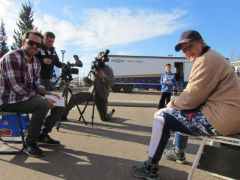
Aufgeregt? Ich bin total am Ausflippen, darf es aber natürlich nicht zeigen und herumhüpfen wie eine Irre, was ich gerne tun würde. Also die erste Frage …
Dann werden noch Filmaufnahmen gemacht, wie ich etwas am Quad mache, das Roadbook anschaue, mit Fernando spreche und schon ist es vorbei. Das gesamte Team im Hintergrund gratuliert mir zu meinem ersten Interview. Gaston ist ein wenig stolz, wenn er auch sagt, dass er als erfahrener Pilot noch nie von Fox Sports aufgenommen wurde. Aber kaum sei eine Schweizerin und auf dem Platz, sei das eine Sensation und alle Journalisten liessen ihn links liegen.
Als ich mit 14 Jahren mein erstes Töffli bekam und damit zur Schule fuhr, war ich da schon immer auf einer Rallye. Der Schulweg war immer der gleiche, aber für mich war es jedes Mal ein anderes Rennen. Ab und zu habe ich während der Fahrt auch Interviews gegeben und mir vorgestellt, wie das so sei. Es ist genau so, wie ich es mir immer vorgestellt habe…
In January 2014 when I was sitting in front of the TV and watching the transmission from the rally Dakar by Fox Sports, Bruno Emori told me to start my project Dakar. I remember the very important sentence: “Why are you sitting in front of the TV and why are you not in the TV?” Now I shall be in the TV. Cameras are installed, I get a microphone and a transmitter, a lot of cables and I’m sitting on a little stool in front of my quad and I the first question is: Are you nervous?
Nevous, excited? I could freak out, but I can not show it and jump around as a fool which I like to do. So, first question …
After the interview they are going to take some more shots, like I do something with my quad, looking at the road book, talking to Fernando and then it’s over. The whole team is “back stage” and congratulates after my first interview. Gaston is a little bit proud but then he said. I’m an experienced pilot but Fox Sports has never taken me. But as soon as there is a Swiss women on place, it’s a sensation and journalists are not even looking at me.
When I have got my first moped when I have been 14 years old and driving with it to school, I always was racing a rally. It was always the same route but for me, always a different stage. Sometimes I also have given interviews during my trip to school. I imagined who it must be. It is exactly what I imagined always.
Desafio Ruta 40 / 17.06.2016 technische Abnahme Tagebuch – Diary
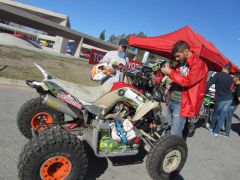
Der nächste Höhepunkt ist die technische Abnahme des Fahrzeuges. Der neue Helm wird nun ausgepackt und auch eine Motocrosshose. Meine Trainerhose hat bereits eine Flickstelle, weil ich damit an den heissen Auspuff gekommen bin. Man geht mit einem vorgewärmten Quad an die Abnahme, denn dort wird auch die Lautstärke des Auspuffgeräusches gemessen.
Der Helm wird ebenfalls kontrolliert, ob und was man als Werkzeug dabei hat, ob die vorgeschriebenen 3 Liter Trinkwasser im speziell dafür vorgesehenen Tank am Fahrzeug sind, Kettenschutz, Instrumente, Antennen, Stromversorgung und so weiter.
„Big Brother“ kommt ohne Beanstandungen durch. Es geht nun wieder zurück ins Servicezelt. Inzwischen hat sich das Biwak mit Zuschauern gefüllt. Klar fahren alle Piloten Schritttempo, es ist aber trotzdem ein wenig schwierig, sich durch das Gewusel zu kämpfen. Viele Zuschauer möchten gerne noch schnell ein Foto machen. Also weisen alle Piloten diese höflich darauf hin, dass sie das am Servicezelt gerne machen können. Im Biwak herrscht für alle Piloten strenge Disziplin und Kontrolle. Racen können wir ab morgen!
Nun, da ich alle Abnahmen und Registrierungen überstanden habe, kommen in mir Emotionen hoch. Eine unbändige Freude, das Grinsen im Gesicht geht kaum mehr weg. Nun bin ich bereit für mein erstes Fernsehinterview bei Fox Sports.
Arrived at the service tent, a presenter of the TV station Fox Sports is going to beg for an interview. But I have to postpone it to a later moment. First I have to prepare my quad. With Gaston we have agreed to make a competition who is going to coil the starting numbers better. Not so easy and I remember Astrid Bürgi. She really knows to do it properly. I have observed how she does it, but the numbers on the rear fenders are really difficult. Mikel helps me out and gets the price of “heroe of the day”.
The next highlight is the technical approval of all vehicles. I also prepare my new helmet and I get into my motocross trousers. My training pants have already a hole because I have burnt them on the hot exhaust… We go with warm machines to the approval because they do also measure the volume of the exhaust noise.
The helmet is checked, too. As well the tools we have with us, if we have the 3 litres of drinking water in our external tank on the quad, the chain protection, instruments, antennas, electricity connections and so on.
“Big Brother” gets his approval without any remarks. Now I have to go back to the service tent. In the meantime the bivouac is full of visitors. All pilots are driving slowly but it is not easy to go back in this crowd. A lot of visitors want to get a photo but we have to tell them to come to the service tent of the team. All pilots have to behave with a lot of discipline and kindness. The race starts tomorrow!
After the points “administration” and “technical approval” I’m full of emotions and a big joy. I do not get rid of the smile in my face. Now I’m ready for my first interview.
